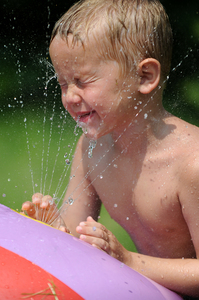Top 6 tips for beating the heat from the Red Cross; also, know the signs of heat stroke
With a heat advisory in effect for the next couple of days, it's time to brush up on hot weather safety and cooling-off strategies. Follow these tips from the American Red Cross to stay as cool as possible in hot weather:
1. Dress for the heat: Wear lightweight, light-colored clothing. Light colors will reflect away some of the sun's energy. It is also a good idea to wear hats or to use an umbrella.
2. Drink water: Carry water or juice with you and drink continuously even if you do not feel thirsty. Avoid alcohol and caffeine, which dehydrate the body. Avoid using salt tablets unless directed to do so by a physician.

Derrick Gentry, 4, at the Wee Wisdom Child Development Center in Ann Arbor, has one idea to beat the heat. The Red Cross has a few other suggestions.
Melanie Maxwell | AnnArbor.com
4. Slow down: Avoid strenuous activity. If you must do strenuous activity, do it during the coolest part of the day, which is usually in the morning between 4 and 7 a.m.
5. Stay indoors when possible: If air-conditioning is not available, stay on the lowest floor out of the sunshine. Remember that electric fans do not cool, they simply circulate the air.
6. Be a good neighbor: During heat waves, check in on elderly residents in your neighborhood and those who do not have air conditioning.
Learn to recognize these heat-related illnesses:
Heat cramps: Muscular pains and spasms due to heavy exertion. Although heat cramps are the least severe, they are an early signal that the body is having trouble with the heat.
Heat exhaustion: This condition typically occurs when people exercise heavily or work in a hot, humid place where body fluids are lost through heavy sweating. Blood flow to the skin increases, causing blood flow to decrease to the vital organs. This results in a form of mild shock. If not treated, the victim may suffer heat stroke. Signals of heat exhaustion include cool, moist, pale flushed or red skin; heavy sweating; headache; nausea or vomiting; dizziness; and exhaustion. Body temperature will be near normal.
Heat stroke: Also known as sunstroke, heat stroke is life-threatening. The victim's temperature control system, which produces sweating to cool the body, stops working. The body temperature can rise so high that brain damage and death may result if the body is not cooled quickly. Signals include hot, red and dry skin; changes in consciousness; rapid, weak pulse; and rapid, shallow breathing. Body temperature can be very high—sometimes as high as 105 degrees.


Comments
treetowncartel
Tue, Jun 7, 2011 : 6:04 p.m.
Was I seeing a mirage today when I saw what appeared to be a Red Cross service vehicle in the form of a Hummer H-3?